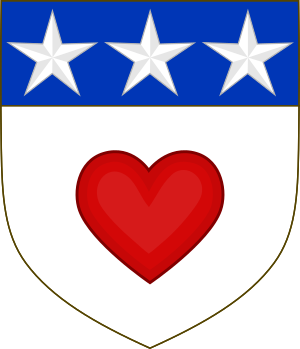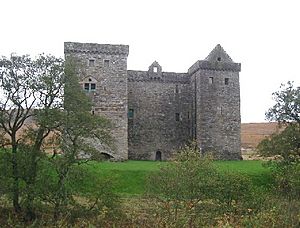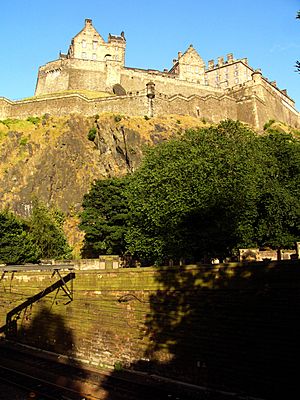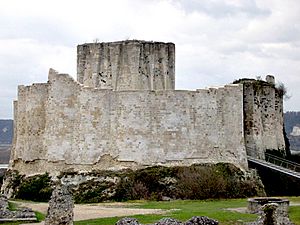William Douglas, Lord of Liddesdale facts for kids
Quick facts for kids
William Douglas
Lord of Liddesdale
|
|
|---|---|

Arms: Argent a heart Gules on a chief Azure three mullets of the first.
|
|
| Died | 1353 |
| Resting place | Melrose Abbey |
| Spouse(s) | Elizabeth |
| Children | Mary Douglas |
| Parent(s) | James Douglas of Lothian |
Sir William Douglas, also known as the Knight of Liddesdale, was an important Scottish nobleman and soldier. He lived from around 1300 to 1353. People also called him the Flower of Chivalry because he was a brave and skilled fighter. He played a big part in the wars for Scotland's freedom against England.
Contents
Early Life and Family Connections
William Douglas was born around 1300. His father, James Douglas of Lothian, owned a small amount of land. William was a distant cousin of the famous Scottish hero, "Good Sir James" Douglas. This hero fought alongside Robert the Bruce in the First War of Scottish Independence.
Around 1323, William took over his family's lands. A few years later, around 1327, he became the godfather to his young cousin, William. This younger William later became the first Earl of Douglas. Our William Douglas was not very well known until 1332.
Scotland's Troubles Begin
Scotland faced new challenges after Robert the Bruce died in 1329. His son, David II, was still a child king. Meanwhile, Edward III became king of England. He was angry about how Scotland had defeated his father. He also disliked the peace treaty signed in 1328.
In 1330, the "Good Sir James" Douglas died while on a journey. This left Scotland without one of its greatest leaders.
The Disinherited Nobles
A group of powerful nobles, called the Disinherited, wanted their lands back in Scotland. They had lost their lands after Scotland won its freedom at the Battle of Bannockburn. In 1331, they brought Edward Balliol back to Scotland. Edward Balliol was the son of a former Scottish king, King John. These nobles wanted Balliol to be king so they could get their lands and power back.
King Edward III of England secretly supported Balliol and the Disinherited. In 1332, Balliol's forces sailed to Scotland. They defeated the Scottish army at the Battle of Dupplin Moor. Balliol was crowned King of Scots on September 24.
However, Balliol did not have much support in Scotland. His army was weakened by Scottish fighters using surprise attacks. William Douglas first appeared in battle during this time. He fought when Balliol was ambushed at the Battle of Annan in December 1332. Balliol had to quickly escape south to England.
The War Continues
In 1333, King Edward III of England openly attacked Scotland. He broke the peace treaty and attacked Berwick-upon-Tweed. William Douglas's cousin, Sir Archibald Douglas, was now Scotland's leader. He rushed to fight the English.
At the Battle of Halidon Hill, the Scots suffered a terrible defeat. Sir Archibald was killed, and many Scottish leaders were captured. Young King David II and William Douglas's godson escaped to France for safety. Edward III put Balliol back on the Scottish throne.
In 1335, Edward III invaded Scotland again with a huge army. He took Edinburgh Castle and made it much stronger.
Douglas Fights Back
William Douglas had been captured earlier in 1333. This meant he missed the terrible defeat at Halidon Hill. After being released in 1334, he began leading raids in Scotland. He fought under John Randolph, 3rd Earl of Moray, another Scottish leader.
After Randolph was captured, Douglas started to build his own fighting force. He returned to his lands and gathered a group of loyal fighters. These men followed him because of his great skill in battle.
Douglas and other Scottish leaders fought a "guerrilla war" against the English. This meant they used surprise attacks and hid in forests and hills. They lived simply and were always on the move. Douglas was wounded twice but kept fighting larger English forces.
Historians later praised Douglas and his fighters. They called them "schools of Knighthood" and gave Douglas the nickname Flower of Chivalry. This was just like how they praised his cousin, the "Good Sir James," for similar tactics.
Actions in Southern Scotland
Douglas did not have many tenants on his land to form a large army. So, he relied on his family and friends to lead his fighting groups. In his home area, his strong leadership won over local nobles. But across the rest of southern Scotland, his military victories gained him great support.
People began to see him as a new "Good Sir James." They called him the "Flail of the English and Wall of the Scots."
Battle of Culblean
In September 1335, the Scottish supporters of King David II chose Sir Andrew Murray as their new leader. A month later, Murray's army met the English-backed forces at the Battle of Culblean. Douglas led the front part of Murray's army.
Douglas pretended to hesitate, making the enemy charge downhill. When their ranks broke, Douglas ordered a counter-attack. Sir Andrew Murray then attacked the enemy from the side. The enemy army broke and fled. Their leader, David de Strathbogie, refused to surrender and was killed.
The Battle of Culblean was a very important victory for King David's supporters. It greatly weakened Balliol's forces.
In 1339, Douglas visited King David II in France. He returned with French knights and crossbowmen, plus weapons and armor. He promised to help prepare for the King's return to Scotland. Douglas then helped capture Cupar Castle and Perth. After these victories, the French fighters returned home.
Taking Control of Border Castles
In the late 1330s, Douglas continued to strengthen his power in southern Scotland. He used the Ettrick Forest for cover, just like the "Good Sir James" had done. From there, he launched more and more successful raids against the English.
In 1337, William Douglas took control of Liddesdale from the English. The next year, he captured Hermitage Castle. This castle was a very important fortress in the border region. It had been an English stronghold.
Capturing Edinburgh Castle
By 1341, Douglas was so skilled that he was able to recapture Edinburgh Castle. This castle had been held by the English since 1335 and was very well defended. It was impossible to climb the castle rock like in 1314. Douglas had to come up with a new plan. He decided to use an old trick, like the Trojan Horse.
The castle needed supplies, so merchants often brought goods inside. Douglas and his men dressed as merchants. They hid their fighters inside wagons filled with hay. When they entered the castle, the last wagon stopped, blocking the gates from closing. Douglas's men jumped out of the wagons. People from Edinburgh then rushed in through the open gates. They defeated the English defenders, throwing many off the castle rock.
Controlling Edinburgh Castle gave Douglas great power over southern Scotland. However, his power was not officially recognized by the Scottish government. He felt he needed to visit King David II in France to gain his support.
King David II Returns
In July 1342, King David II returned to Scotland. He gave Douglas the title of Earl of Atholl. However, Douglas only held this title for a few months. He had to give it up to Robert Stewart, the King's uncle. Later in 1342, the King gave Douglas other lands in Eskdale and Ewesdale.
Douglas also had some disagreements with Robert Stewart over land. This showed that Douglas did not have the same close bond with King David II that the "Good Sir James" had with Robert the Bruce.
The Death of Ramsay
William Douglas and another Scottish leader, Sir Alexander Ramsay, were rivals. This rivalry grew stronger after Ramsay recaptured Roxburgh Castle from the English in March 1342. Douglas had tried to retake it many times without success. For this brave act, King David II made Ramsay the constable of Roxburgh and Sheriff of Teviotdale. This made Douglas very angry.
Because of this, or other reasons, Douglas led his men to Hawick. There, they captured Ramsay and took him to Hermitage Castle. Ramsay was imprisoned there and died without food or water.
About a year later, after Robert Stewart stepped in, Douglas was back in the King's favor. He was given back his important positions by late 1342.
Battle of Neville's Cross
In 1346, most of the English army was fighting in France. The French king asked King David II of Scotland to attack England's northern border. King David agreed. He led about 12,000 men into England. They raided parts of Cumberland and Northumberland.
On October 17, William Douglas's men went on a rampage near Durham. They met an English army of about 6,000 to 7,000 soldiers. The English defeated Douglas's men in this first fight. The main battle took place near a stone cross called Neville's Cross.
The Scottish forces were overwhelmed. King David was badly wounded in the face by two arrows. He fought bravely, even knocking out two teeth of the man who captured him. King David was held prisoner by the English for eleven years.
Douglas Returns from Prison
After the battle, William Douglas was also captured and held in the Tower of London. He remained a prisoner for many years.
Even in prison, Douglas was still involved in Scottish affairs. In 1350, he arranged for the killing of Sir David Barclay. This was to get revenge for Barclay's murder of Douglas's brother.
In 1351, King Edward III of England needed money for his wars. He decided to release King David II for a large payment of £40,000. Douglas was also released temporarily. The English hoped he would help convince the Scottish nobles to pay the ransom. Both King David and Douglas rode north with English guards.
However, they failed to get the ransom money. Both were sent back to the Tower of London. King Edward then tried to get Douglas to switch sides. Douglas agreed to a deal:
- He would give up Liddel Castle.
- He would be loyal to the English king against all enemies, except the Scots, unless he chose to fight them.
- He would send his daughter and his nephew to England for two years.
In return, Douglas would be set free. He would also get back Liddesdale, Hermitage Castle, and some lands in Annandale. Douglas was released in July 1352. He hoped to get support from Scots who favored England. But another powerful Scottish leader, William, Lord Douglas, had already gained the loyalty of those Scots.
Death of William Douglas
William Douglas found that much had changed in Scotland during his eleven years in prison. William, Lord Douglas, had become very powerful in his absence. In fact, while the Knight of Liddesdale was making a deal with England, Lord Douglas was fighting to keep the English out of Scotland.
One day, while the Knight of Liddesdale was hunting in Ettrick Forest, Lord Douglas met him. Lord Douglas killed the Knight of Liddesdale. William of Liddesdale's body was first taken to a chapel and then to Melrose Abbey for burial. Lord Douglas later gave money to the church for prayers for the man he had killed. The place where he died was renamed William's Hope, and a cross was put there in his memory.
People have debated for centuries why Lord Douglas killed him. Some say it was revenge for the Knight's past actions, like the death of Sir Alexander Ramsay. Others thought it was jealousy, but this is unlikely as Lord Douglas was not married at the time. A third idea is that Lord Douglas found out about the Knight's deal with England and wanted to stop him. Another theory is that Lord Douglas was angry that the Knight had given away lands that belonged to the Douglas family. Lord Douglas did later claim these lands for himself.
In 1354, King Edward III took Hermitage Castle. But he gave it back to Elizabeth, William Douglas's widow. She promised to be loyal to the English king and let English soldiers stay there. She later married an Englishman, and the castle was given to her new husband. After this, Douglas's daughter and nephew were released from prison in London.





